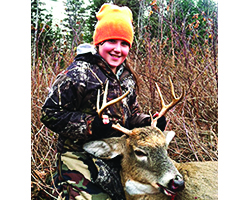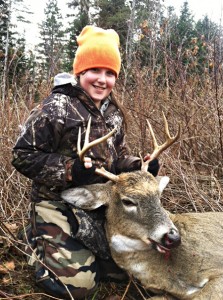

copyright the Chronicle November 12, 2014
by Paul Lefebvre
Between sunrise on Saturday, opening day of rifle season on deer, and closing day at sunset on November 30, hunters will lose roughly 30 minutes of hunting time.
That’s because they can hunt deer from 30 minutes before sunrise and 30 minutes after sunset during the 16-day season.
But sunrise on November 15 comes at 6:45, or 19 minutes earlier than it does on Sunday, November 30 — the last day in the season.
A comparable loss in time occurs at sunset. On Saturday the sun will set at 4:21 compared to 4:10 on the last day of month. Added together and that’s a loss of 30 minutes in real time.
Will it make any difference in hunters’ success rate? Probably not.
According to figures from Vermont’s Fish and Wildlife Department, more bucks are shot during the first week of deer season than in any other time during the 16-day season. In 2013, for example, a whopping 44 percent were taken during the season’s first two days.
Overall, there were 6,725 deer taken during last year’s rifle season — a season that dates back to 1897, making it Vermont’s oldest hunting season. Biologists think hunters may experience an uptick this year.
The size of the deer herd is estimated at 135,000, and department Wildlife Director Mark Scott believes that three back-to-back mild winters may spell a higher success rate for hunters this year.
But deer hunting, like farming, depends a lot on the weather, and nowhere does the winter have a greater effect on hunting whitetail than it does in the Northeast Kingdom and mountainous regions.
If it turns warm, said Mr. Scott, deer head south, and hunters in the big woods have a tough time stalking their prey.
Of the 6,175 deer taken last November, 1,686 were taken in the Northeast Kingdom’s three counties. There were 876 shot in Caledonia County; 609 in Orleans; and 201 in Essex.
The highest number of deer taken in Orleans County was the 76 that came out of Derby. Irasburg, Holland and Morgan all had harvests exceeding 40.
In Essex, hunters enjoyed the greatest success in Concord and Norton where 28 and 24 deer were respectively taken by rifle.
Barnet was the highest reporting town in Caledonia County with a harvest of 49 deer. The largest deer to come out of that county was a 243-pound buck shot in Newark.
When results of the 2013 rifle season are added to the numbers taken during youth weekend, muzzleloading and archery season, Vermont hunters harvested 14,107 deer last year.
Perhaps that’s why roughly 68 percent of rifle hunters interviewed this year found deer hunting in Vermont satisfying, a percentage that Mr. Scott at the department said “took us by surprise.”
The department’s top deer biologist, Adam Murkowski, suggested the high level of satisfaction was a new milestone for the department.
“That’s the highest that’s been recorded by the department,” he said in an interview Tuesday.
He attributed the high marks in satisfaction to a heightened confidence by hunters in the department’s ability to manage the herd.
It was too early in the week to know how youth hunters fared over the weekend during the annual two-day deer season, set aside for youngsters 15 and under.
Mr. Murkowski said he expects the harvest would be similar or a little higher than last year’s tally.
While the number of resident hunting licenses sold in Vermont continues to decline — down to 63,427 from 71,587 five years ago — the youth weekend has become an important component in the department’s efforts to manage the deer herd.
On one hand they are helping to take up the slack as the number of new hunters decline. Mr. Murkowski noted there is only one new hunter for every two hunters lost, a statistic that is also showing up in other states. Youth hunters are critical to the future of deer hunting, he added.
Results of a recent study further indicated that 50 percent of Vermont hunters have no other family member who shares their interest in hunting.
Roughly 60,000 hunters are expected to take to the Vermont woods on opening day this coming Saturday. According to a study conducted for the department by Resource Management, a Virginia company, rifle hunters spent an average of 11.4 days last year hunting deer.
That average was slightly higher in the mountainous regions of the state, which includes the Northeast Kingdom, where hunters spent an average of 12 days.
The largest percentage of state hunters, 10 percent, hunted in Rutland County.
The study produced by the Resource Management people was based on interviews with 1,217 hunters. According to its findings, 72 percent support the department’s management of the herd, while 58 percent would support a more regional approach to deer management.
Mr. Scott spoke of the possibility of changing the dates of the rifle season. He noted that more does are presently being bred during the last week of November, which is prime time for hunting buck.
According to the survey, 48 percent of the hunters interviewed from the mountain region would support such a change. But the most surprising statistics from the survey indicated that the greatest number of Vermont deer hunters live in Chittenden County. It leads with 13 percent, compared to 11 percent for Rutland County and 10 percent for Franklin.
contact Paul Lefebvre at [email protected]
For more free articles from the Chronicle like this one, see our Featuring pages. For all the Chronicle’s stories, subscribe:
Print subscription
Annual online subscription
Short-term online subscription







